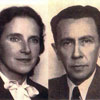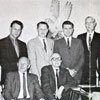Post WWII Immigrants
During and after the Second World War, Europe was characterized by political instability and Estonia was no eception. Tens of thousands of Estonians left their homeland before the end of World War II to escape the forceful occupation of the country by the Soviet Union. The majority of these refugees crossed the Baltic Sea to Sweden or travelled overland to Germany. By the late 1940's and early 1950's, thousands of these refugees emigrated to USA, Canada, Australia and South America.
Of the thousands who settled in Canada during this period, an estimated 400 Estonians arrived in Alberta and settled primarily in the province's two major urban centres, Calgary and Edmonton. They banded together by forming societies to celebrate cultural traditions such as Jaanipäev (Midsummer Eve), Christmas and Estonia's Independence Day. The ranks of first-generation immigrants were reduced by the end of the 20th century, resulting in the formation in 2004 of a province-wide heritage organization, the Alberta Estonian Heritage Society. Membership is comprised of multi-generational descendants of Alberta's Estonian pioneers and post-WWII immigrants.












